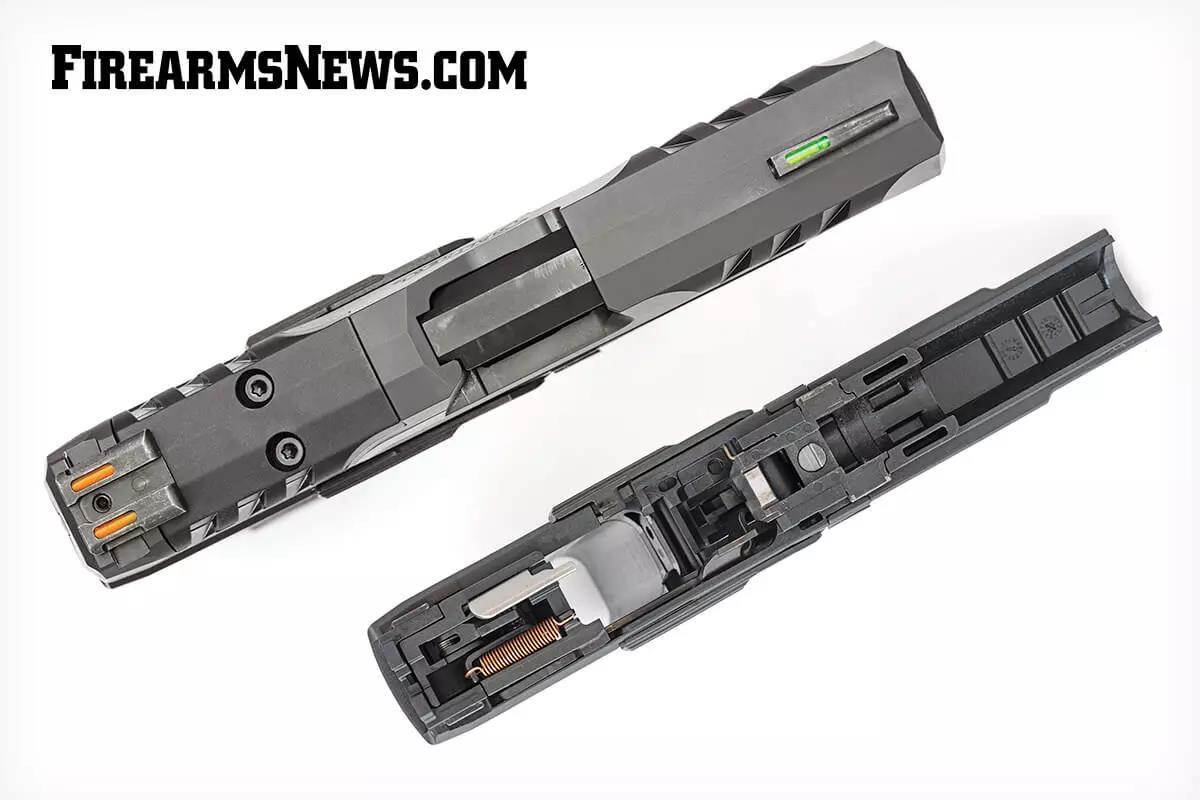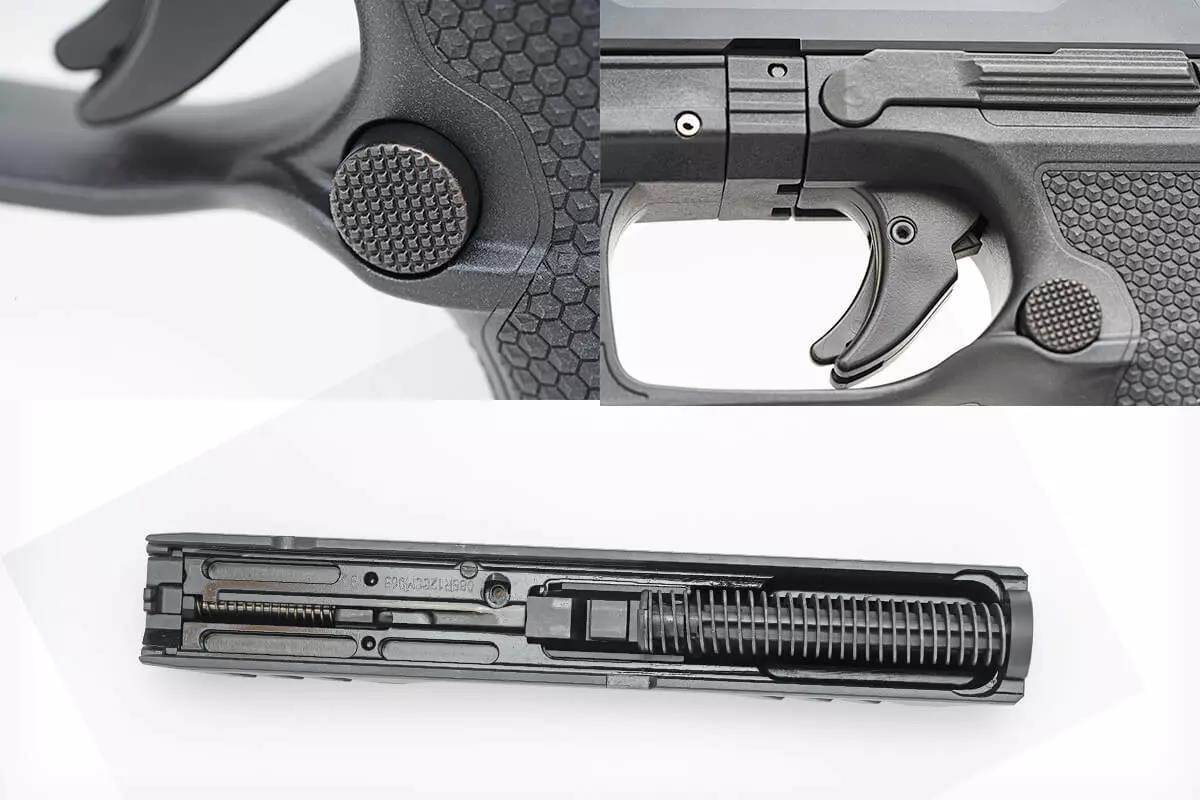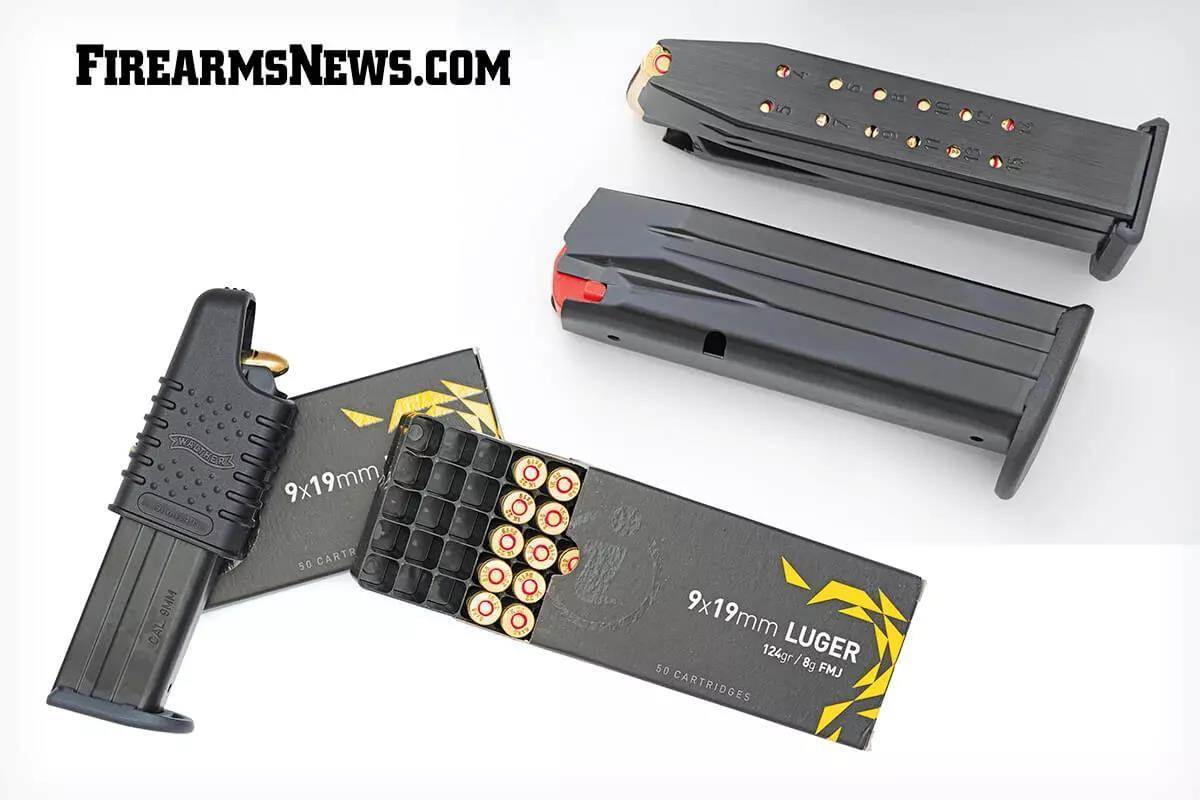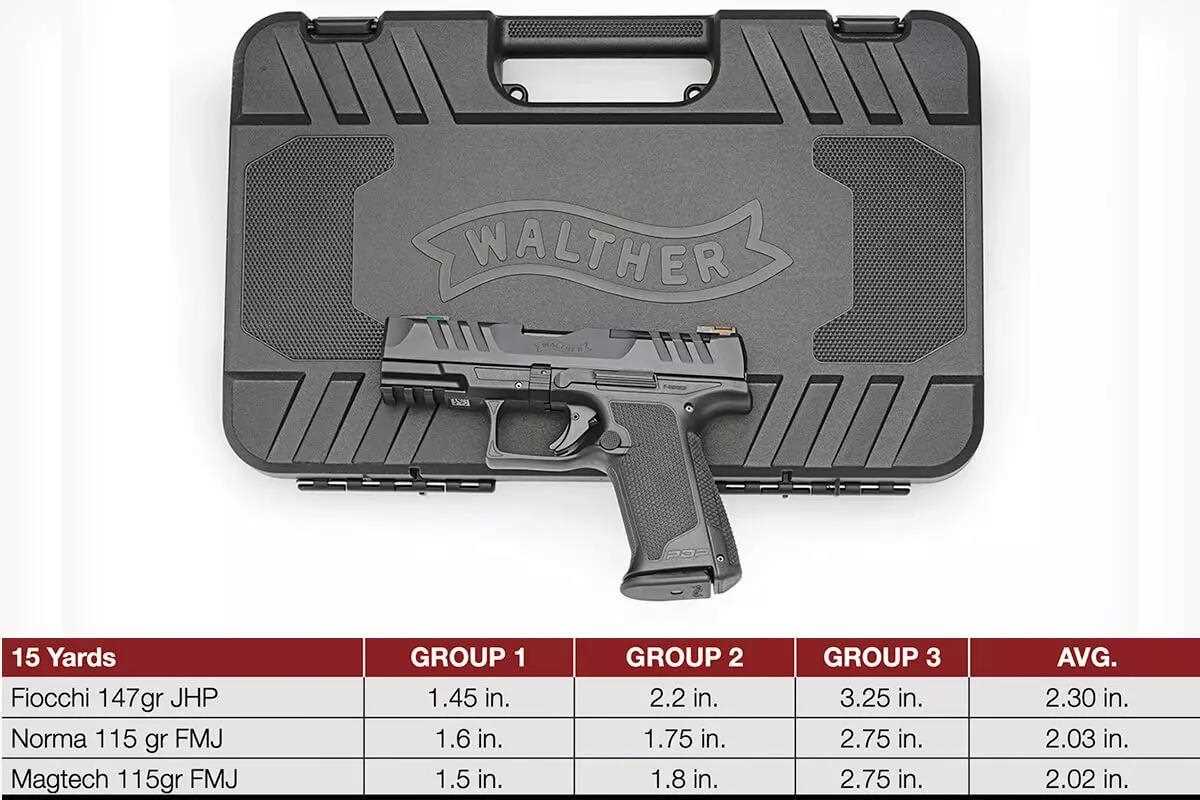Affiliate Disclosure: This page contains affiliate links. We earn from qualifying purchases.
The story began in 2021, with the introduction of Performance Duty Pistol, Walther PDP. A fairly conventional polymer-framed sidearm with partially cocked striker action, it increased modularity compared to the preceding PPQ. The striker design hearkened back to the P99QA, while the optic-ready slide and ambidextrous slide stop lever kept up with the times. PDP was phenomenally successful for Walther, winning multiple Guns of the Year awards. Available with three slide lengths and two grip lengths, it gave the options of 15- or 18-shot capacity, four-inch, 4.5-inch or five-inch barrel length. Polymer frame kept the overall weight of the full-size four-inch down to a svelte 24 ounces, while the ergonomic grip moderated felt recoil. PDP rapidly gained popularity with shooters whose hands were large enough to grip it, but another subset of the population had to wait for the introduction of the F-series in 2022.
F-series is marketed towards shooters with smaller hands, mainly women. The grip is slimmer, the trigger sits an inch further back and has shorter travel. While regular PDP slides are compatible with PDP-F frames, F-series pistols are easier to rack thanks to the two-piece striker reducing the effort required by about 20%. The original grip already placed the magazine release button far back for accessibility, but the
reduced size grip makes it easy even for people with tiny hands to reach all important controls. Ambidextrous slide stop levers project back far enough for easy reach and excellent leverage. I first became familiar with the design through the world-famous instructor Tatiana Whitlock.
She, along with competitive shooter Gabby Franco and several other women, formed the advisor group for Walther in the development of a female-friendly handgun that wasn’t just small and pink. My interest in PDP-F grew as I worked with Angel Kim, an American originally from Korea: at five foot even height, and proportional build, Angel had difficulty reaching controls of most service-size handguns. Subcompact pistols carried heavier recoil and reduced the magazine capacity, while full-side grips meant breaking the hold to operate the controls. Grand Power K100 series came closest in low recoil and trigger reach, but the magazine release was
too far forward and too stiff for her to run with the right hand.

The shortest 3.5-inch PDP-F satisfied all requirements—the trigger, the slide stop, and the reversible magazine release button were all easy to operate with one hand. Felt recoil and muzzle flip were moderate enough to permit one-handed shooting if necessary. The heavily sculpted SuperTerrain slide gave plenty of purchase for racking, and the reduced racking effort was also appreciated. Instructors at Nashville Glockstore let her try a variety of pistols, PDP-F came up as the clear favorite. Since Ms. Kim’s visits to Nashville were limited on time, she worked extensively with several instructors over consecutive days. This is where the good fit and moderate recoil of the pistol really shined, enabling extensive practice without undue fatigue or pain. Unlike certain makers who pride themselves on abrasive grip stippling, Walther uses a subdued pyramid texture to provide a non-slip surface that’s easy on the skin. The slightly undercut trigger guard flares where it joins the grip, providing both fencing against accidental depression for the magazine release and a smooth surface for the side of the middle finger, thus sparing chafing from recoil. Training becomes so much easier when the pistol doesn’t pose an injury threat to the user!

In many ways, the original and the F series are similar. They use the conventional tilt-barrel Browning lockup, external extractors, and extensive beavertails to enable a high grip. Curved triggers with hinged safety tabs are shaped just right to provide good leverage to work the 5.6-pound effort required to fire the pistol. The triggers feel a little different from each other, with the F trigger having less take-up and a clearer reset position. Trigger reset happens at a later point during slide travel than on the regular PDP. I can’t say that one or the other version is better, just that they are both optimized for rapid fire more than for precision.

Being service pistols, both feature lanyard loops. Both use the same 15-round magazine also common to compact PPQ, and both can use longer 18-round magazines for full-size PDP and Canik pistols. F-series fits the same holsters as regular PDP, further improving the logistics of this offering. JM4 Tactical makes excellent leather-like polymer IWB and tuckable options, as do numerous other manufacturers. PDP shells for deep concealment modular Enigma holster allow rapid-access carry in a variety of clothing with outward signs of the weapon.

The pistols arrived with white dot adjustable sights. Since the sight standard is Glock-compatible, it was easy to find a wide variety of aftermarket upgrades. Being more concerned with short-range use, my friends and I all opted for the superb HiViz H3 sights that combine tritium vials with fiberoptic rods, giving high visibility day or night. These are longer than usual, so the rear sights blocked the optic mounting plates. Had red dot sights been preferred, the users would have had to reinstall the original short rear sights and contact Walther for the appropriate adapter plates. Instead of shipping several inexpensive adapter plates like Glock for their MOS line, Walther includes the choice of one plate per pistol at no charge but supplies a more robust solution. For the shorter 3.5-inch slide, optics made more sense to compensate for the reduced iron sight radius. Other than the optic plates, PDP-F arrives ready for use.

The airline-approved pistol boxes contain spare magazines, a loading tool, mandatory cable locks, and a spare backstrap for regulating the natural point of aim. The magazine loading tool proved unnecessary, as the mags are easy enough to load by hand. The Disassembly process is typical for striker-fired pistols: verify clear, dry fire, pull the latch in front of the slide stop lever hinge down while pulling the slide back a little before easing it forward and off the frame.

The captured recoil spring comes off and reinstalls easily. PDP runs fairly cleanly, in which polygonal rifling of the barrel helps considerably. Reliability of both 3.5-inch and four-inch PDP-F pistols were used was boringly absolute—no malfunctions of any kind with any ammunition type or brand. Fiocchi and Federal hollow points, Magtech, Norma, and Igman FMJ, all worked well. Accuracy was similar with all types as well: judging by the results of slow, deliberate fire at 15 yards with both hands and the forearm rested on sandbags, the limiting factor was my insufficient mastery of the trigger.

Groups fired with the same ammunition differed greatly from string to string, ranging from a respectable 1.5 inches to a less wonderful 3.25 inches. Groups size did not appreciably change from switching to unsupported shooting. In practical terms, that meant consistently staying on a silhouette out to about 50 yards but no further. For a defensive sidearm, that’s a reasonable standard of performance. For reference, I fired a Smith & Wesson Model 10 revolver in .38 Special and a Grand Power XCalibur longslide pistol in 9mm (GrandPower.eu) at the same distance and got repeatable dispersion of about 1.5 inches from both — single action triggers making all the difference. Better shooters have achieved much better results, down to 0.5 in. at the same distance using defensive ammunition and red dot sights. The regular four-inch PDP with identical HiViz sights (fired for comparison) turned in consistent groups in the 1.25- to 1.5-inch range, suggesting that the fuller grip and different trigger work better for shooters with large hands. Shooters with small hands got better accuracy and easier handling with the slimmer F model.
Recommended

Firing for speed against a gallon milk jug hanging from a string, the results were consistently encouraging at ten yards, 15 out of 15 shots hit even as the jug was moving from previous impacts. Also helpful to defensive use: the railed dust cover is internally reinforced for stiffness, so a laser attached to it would stay aligned once zeroed. The main attraction of PDP-F, besides the traditional Walther reliability, is the grip. The slimmed-down grip dimensions were based primarily on the extensive demographic data gathered by Walther from their custom competition pistol grips. As a result, they managed a “two size—counting the extra backstrap option—fit all” solution that actually works.

Not only is this a comfortable pistol for two-hand firing grip, but it can also be effectively used one-handed as well. For self-defense use, that’s a major concern. Kudos to Walther for approaching the technical and ergonomic challenge from the ground up instead of just slapping pink grips onto an existing design! It was also a sound investment for them, as a significant portion of current and new shooters in the US are female.

Men with small hands would also find this variant preferable, as would both sexes living in cold climate where glove material thickness absorbs part of the circumference available for gripping a gun. In use, the short and the long versions of the pistol differed little. The slightly reduced sight radius of the shorter pistol was offset by the greater stability. The only mechanical difference between the two was in the recoil springs: 3.5-inch pistol uses dual spring assembly, four-inch single spring. For appendix carry, the shorter slide is a definite win. For belt carry, the extra half-inch would make much less difference. In fact, fans of longer pistols with slim grips can mount the five-inch PDP slide on the F lower and have all the velocity and the side radius without the frame bulk. Ergonomics and modularity seem to be the byword for PDP-F, with excellent performance as the result. While meant for women, it works equally well for all shooters. Tested side by side with the regular PDP, it received an equal share of fans.

Walther PDP F-Series Specs
- Caliber: 9mm Luger
- Color: Black
- Slide Material: Steel
- Frame: Polymer
- Overall Length: 6.5 in.
- Width: 1.34 in.
- Height: 5.4 in.
- Barrel: 3.5 in.
- Sight Radius: 5.9 in.
- Trigger Reach: 2.56 in.
- Grip Circumference: 5.5 in.
- Weight: 20.3 oz.
- Capacity: 15 rds., includes 2 magazines
- Trigger: PDT-F, 5.6 lbs.
- MSRP: $699
- Contact: Walther Arms
Read the full article here


